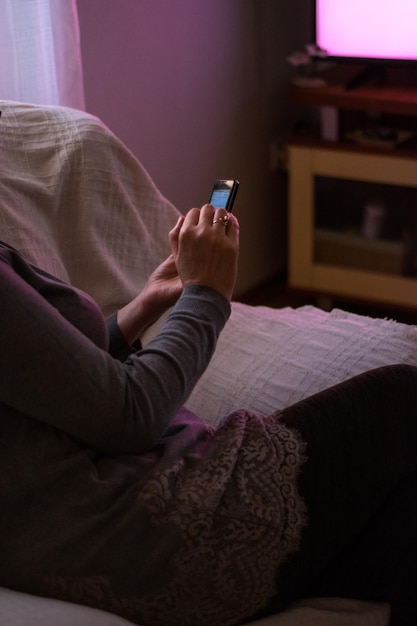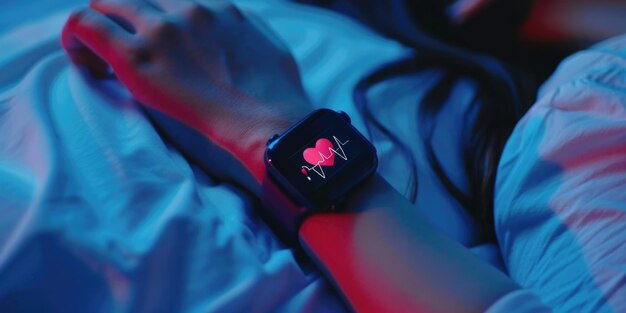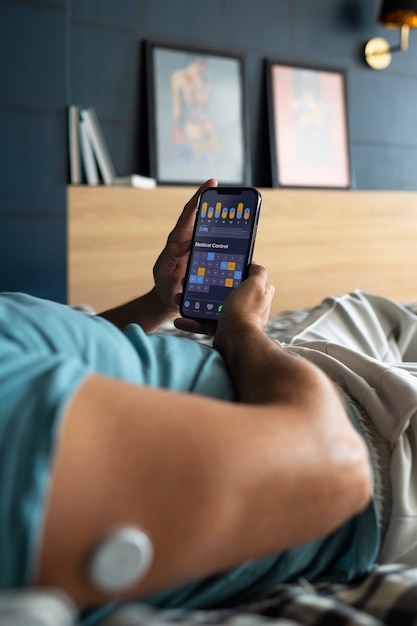Latest Sleep Tech: Can Wearables Really Improve Your Sleep?

The latest trends in sleep technology focus on wearable devices designed to monitor and improve sleep quality through personalized insights and interventions, offering potential solutions for those struggling with sleep disorders.
Are you struggling to get a good night’s rest? The realm of sleep technology is rapidly evolving, with the latest trends in sleep technology focusing on wearable devices designed to improve your sleep quality. These innovative gadgets promise to offer personalized insights and interventions to help you achieve a more restful and rejuvenating sleep.
Understanding the Rise of Sleep Technology
Sleep technology has emerged as a significant area of innovation, driven by increasing awareness of the importance of sleep for overall health and well-being. With millions struggling with sleep disorders, the demand for effective and accessible solutions is higher than ever.
This field encompasses a wide range of devices and applications, from smart mattresses to sophisticated wearable sensors. The core goal is to provide users with data-driven insights into their sleep patterns and offer tools to optimize their sleep environment and routines.
The Growing Need for Sleep Solutions
The prevalence of sleep disorders, such as insomnia and sleep apnea, highlights the critical need for effective sleep solutions. These conditions can significantly impact physical and mental health, leading to decreased productivity, increased risk of chronic diseases, and a lower quality of life.
The Role of Data in Improving Sleep
Data plays a crucial role in the effectiveness of sleep technology. Wearable devices and other sleep-tracking tools collect various data points, including sleep duration, sleep stages, heart rate, and movement. This data is then analyzed to provide users with personalized insights and recommendations for improving their sleep.
- Personalized Insights: Tailored feedback based on individual sleep patterns.
- Data-Driven Decisions: Informed choices about sleep habits and routines.
- Tracking Progress: Monitoring the impact of interventions over time.
Ultimately, the rise of sleep technology reflects a growing understanding of the importance of sleep and a desire to leverage technology to achieve better rest and overall well-being. The continuous development of new and innovative solutions promises to further enhance our ability to understand and improve our sleep.

In conclusion, the increasing awareness of sleep’s importance, coupled with technological advancements, is driving the growth of sleep technology. Data-driven insights and personalized recommendations are key components in helping individuals improve their sleep quality and overall health.
Key Features of Wearable Sleep Devices
Wearable sleep devices have become increasingly popular for their ability to track and analyze sleep patterns. These devices come equipped with a variety of features that provide users with valuable insights into their sleep habits.
Understanding these key features can help you make an informed decision when choosing a wearable device to monitor and improve your sleep. From basic sleep tracking to advanced biometric monitoring, these devices offer a range of functionalities.
Sleep Tracking and Analysis
The primary function of wearable sleep devices is to track and analyze sleep patterns. This includes monitoring sleep duration, sleep stages (light, deep, REM), and wakefulness. By accurately tracking these metrics, users can gain a comprehensive understanding of their sleep quality.
Biometric Monitoring
Many wearable sleep devices also incorporate biometric monitoring features, such as heart rate tracking, heart rate variability (HRV) analysis, and respiratory rate monitoring. These metrics can provide additional insights into sleep quality and overall health.
- Heart Rate Tracking: Monitoring heart rate patterns during sleep.
- HRV Analysis: Assessing the balance between the sympathetic and parasympathetic nervous systems.
- Respiratory Rate Monitoring: Tracking breathing patterns for potential sleep apnea indicators.
The combination of sleep tracking and biometric monitoring offers a holistic view of sleep health, allowing users to identify potential issues and make targeted improvements. As technology advances, these features are becoming more sophisticated and accurate, providing even greater value to users.
In summary, wearable sleep devices offer a range of key features, including detailed sleep tracking, biometric monitoring, and personalized feedback. These functionalities empower users to take control of their sleep health and make informed decisions to improve their sleep quality.
Benefits of Using Wearable Sleep Trackers
Wearable sleep trackers offer numerous benefits for individuals looking to improve their sleep quality. These devices provide valuable data and insights that can lead to better sleep habits and overall health.
By understanding the advantages of using wearable sleep trackers, individuals can make informed decisions about incorporating them into their sleep improvement strategies. From personalized feedback to early detection of sleep disorders, these devices offer significant potential benefits.

Personalized Insights and Feedback
One of the primary benefits of wearable sleep trackers is the personalized insights and feedback they provide. By analyzing individual sleep patterns, these devices can offer tailored recommendations for improving sleep quality. This can include suggestions for adjusting sleep schedules, optimizing sleep environments, and managing stress levels.
Early Detection of Sleep Disorders
Wearable sleep trackers can also play a role in the early detection of sleep disorders. By monitoring sleep patterns and biometric data, these devices can identify potential indicators of conditions such as sleep apnea, insomnia, and restless legs syndrome. This early detection can prompt individuals to seek professional medical advice and treatment.
Improving Sleep Hygiene
Sleep hygiene refers to the habits and practices that promote healthy sleep. Wearable sleep trackers can help users improve their sleep hygiene by providing reminders to maintain consistent sleep schedules, create a relaxing bedtime routine, and avoid stimulants before bed.
- Consistent Sleep Schedules: Encouraging regular sleep and wake times.
- Relaxing Bedtime Routine: Promoting activities that help wind down before sleep.
- Avoiding Stimulants: Reminding users to avoid caffeine and alcohol before bed.
The combination of personalized insights, early detection of sleep disorders, and improved sleep hygiene can lead to significant improvements in sleep quality and overall health. As wearable sleep trackers continue to evolve, their potential benefits are likely to expand even further.
In conclusion, the benefits of using wearable sleep trackers are multifaceted, ranging from personalized feedback and early detection of sleep disorders to improved sleep hygiene. These devices empower individuals to take proactive steps towards better sleep and overall well-being.
Potential Downsides and Limitations
While wearable sleep devices offer numerous benefits, it is important to acknowledge their potential downsides and limitations. Understanding these factors can help users manage their expectations and use these devices effectively.
From accuracy concerns to the potential for increased anxiety, there are several limitations to consider when using wearable sleep trackers. Addressing these issues can help individuals make informed decisions and avoid potential pitfalls.
Accuracy Concerns
One of the primary concerns with wearable sleep devices is their accuracy. While these devices have improved significantly over time, they are not always as accurate as clinical sleep studies. Factors such as device placement, individual physiology, and algorithms can affect the accuracy of sleep trackingデータ。
Potential for Increased Anxiety
For some individuals, using wearable sleep trackers can lead to increased anxiety about sleep. Obsessively monitoring sleep data and striving for perfect sleep can create a cycle of anxiety that ultimately يؤثر على جودة النوم بشكل سلبي.
Over-Reliance on Technology
Relying too heavily on technology to manage sleep can also be detrimental. It is important to remember that wearable sleep devices are tools, not solutions. Focusing solely on the data provided by these devices can lead to neglecting other important aspects of sleep health, such as lifestyle factors and mental well-being.
- Lifestyle Factors: Incorporating healthy sleep habits into daily routines.
- Mental Well-being: Managing stress and anxiety through relaxation techniques.
- Professional Advice: Seeking guidance from healthcare professionals when necessary.
In conclusion, while wearable sleep devices can be valuable tools for improving sleep quality, it is important to be aware of their potential downsides and limitations. By managing expectations, using these devices responsibly, and focusing on a holistic approach to sleep health, individuals can maximize the benefits of sleep technology while minimizing its risks.
Future Trends in Sleep Technology
The field of sleep technology is rapidly evolving, with numerous exciting developments on the horizon. These future trends promise to further enhance our ability to understand and improve sleep quality.
From advanced sensor technology to personalized sleep interventions, the future of sleep technology is filled with potential. By exploring these trends, we can gain insight into the innovative solutions that may transform the way we approach sleep health.
Advanced Sensor Technology
One of the key trends in sleep technology is the development of advanced sensor technology. This includes the use of more accurate and sophisticated sensors to track sleep patterns, biometric data, and environmental factors. These sensors will provide more detailed and reliable data, enabling more personalized and effective sleep interventions.
Personalized Sleep Interventions
Another trend is the rise of personalized sleep interventions. This involves tailoring sleep recommendations and treatments to individual needs and preferences. Using data from wearable devices and other sleep-tracking tools,sleep technology companies are developing customized sleep plans that address specific sleep issues and optimize sleep quality.
Integration with Smart Home Devices
The integration of sleep technology with smart home devices is also gaining momentum. This includes the ability to automatically adjust room temperature, lighting, and sound levels based on sleep patterns. By creating an optimal sleep environment, smart home integration can further enhance sleep quality.
- Automated Adjustments: Smart home devices automatically adapting to sleep needs.
- Optimized Sleep Environment: Creating a comfortable and conducive sleep space.
- Seamless Integration: Connecting sleep technology with existing smart home systems.
The future of sleep technology is bright, with numerous innovative solutions on the horizon. As technology continues to advance, we can expect to see even more personalized, effective, and integrated approaches to improving sleep health. By embracing these trends, individuals can unlock the full potential of sleep technology and achieve better rest and overall well-being.
In summary, the future trends in sleep technology are focused on advanced sensor technology, personalized sleep interventions, and integration with smart home devices. These innovations promise to revolutionize the way we approach sleep health and enable individuals to achieve optimal sleep quality.
Choosing the Right Wearable Sleep Device
Selecting the right wearable sleep device can be a daunting task, given the wide range of options available. However, by considering several key factors, individuals can make an informed decision that aligns with their specific needs and preferences.
From accuracy and features to comfort and budget, there are several important considerations when choosing a wearable sleep tracker. By carefully evaluating these factors, individuals can find a device that meets their requirements and helps them improve their sleep quality.
Accuracy and Reliability
One of the most important factors to consider when choosing a wearable sleep device is its accuracy and reliability. Look for devices that have been validated by independent studies and have a reputation for providing accurate sleep data. Reading reviews and comparing data from different devices can help assess their accuracy.
Features and Functionality
Consider the features and functionality that are most important to you. Some devices offer basic sleep tracking, while others provide advanced biometric monitoring, personalized insights, and smart home integration. Determine which features align with your sleep goals and choose a device that offers those functionalities.
Comfort and Wearability
Comfort and wearability are also important considerations, as you will be wearing the device while you sleep. Look for devices that are lightweight, comfortable, and do not interfere with your sleep. Consider factors such as the size and shape of the device, the materials used, and the adjustability of the band.
- Lightweight Design: Ensuring the device is not cumbersome during sleep.
- Comfortable Materials: Choosing materials that are soft and breathable.
- Adjustable Band: Allowing for a customized fit that does not restrict movement.
In conclusion, choosing the right wearable sleep device involves considering accuracy, features, comfort, and budget. By carefully evaluating these factors and aligning them with your sleep goals, you can find a device that helps you track, analyze, and improve your sleep quality.
| Key Point | Brief Description |
|---|---|
| 📊 Data Tracking | Wearables monitor sleep stages, heart rate, and more for personalized insights. |
| 💡 Personalized Feedback | Devices provide tailored recommendations to improve sleep hygiene. |
| 🩺 Early Detection | Wearables can help identify potential sleep disorders like sleep apnea. |
| 😴 Smart Integration | Future tech includes optimizing sleep environments with smart home devices. |
Frequently Asked Questions
▼
Wearable sleep devices use sensors like accelerometers and heart rate monitors to detect movement and physiological changes, differentiating between sleep stages like light, deep, and REM sleep.
▼
While they’ve improved, they aren’t as accurate as clinical sleep studies. Factors like device placement & algorithms influence precision. It’s best to see as direction indicators, not absolute truth.
▼
Some wearables can monitor breathing patterns and blood oxygen levels, which may indicate potential sleep apnea. However, professional medical evaluation is essential for a confirmed diagnosis.
▼
Consider accuracy, needed features, comfort, and budget. Read expert reviews, compare brands, and align your choice with specific sleep goals and identified problem areas in your routine.
▼
Possible downsides include accuracy concerns, anxiety about optimizing sleep metrics, and over-reliance on technology. Maintain holistic view with doctor visits and lifestyle habits for sleep betterment.
Conclusion
In conclusion, the latest trends in sleep technology, particularly wearable devices, offer exciting possibilities for improving sleep quality. While it’s essential to consider their limitations and potential downsides, these devices can be valuable tools for gaining insights into your sleep patterns and making informed decisions to enhance your overall well-being. Embrace technology responsibly, and prioritize a holistic approach to achieving restful and rejuvenating sleep.
